Colbie's Story
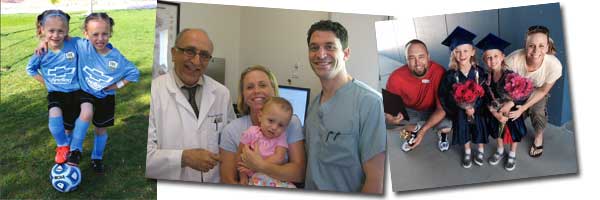
“YOU’RE IN THE RIGHT PLACE.”
These are the first words we heard from Dr. Akbarnia and words we will never forget. They immediately lifted a huge weight off of our shoulders and gave us hope for our daughter after two years of uncertainty.
My husband, Geoff, and I are the proud parents of 6-year-old twin girls, Colbie and Kenna. Today, they look and act like any other First Grader, so much so no one would ever guess that their lives began 15 weeks prematurely due to unforeseen pregnancy complications. Colbie weighed 1 pound 6 ounces and measured 11.5 inches long at birth, while Kenna weighed in at 1 pound 5 ounces and measured 12 inches long. They were immediately put in the care of specialists in the Neonatal Intensive Care Unit (NICU) in Henderson, NV, while I was not able to see them until the following morning, due to my own surgical recovery. Those 12 hours were frightening to say the least. I had no idea if they would survive the night, or what condition I might find them in. Geoff was able to take turns comforting me and watching over them during those first hours as a new family. He kept repeating to me how very small they were, and tried to prepare me for the state in which I would find them the next morning. Despite his best efforts, nothing prepared me for what I was about to see when I first met our beautiful daughters. The girls had tubes, needles, and wires all over their fragile bodies. They were breathing thanks to ventilators. Their eyes were covered to protect them from the light, and their bodies were wrapped tightly by homemade swaddles the nurses had made. Their skin was so thin that it was translucent, and they were protected in highly specialized isolettes that provide moisture control similar to the womb.
Our new daughters spent the next 113 days fighting for their lives in the NICU. Kenna and Colbie each faced their own struggles during that time, but both improved and gained weight slowly. Thankfully, neither had any major medical issues while in the NICU, except for one specific problem with Colbie. At roughly 12 weeks of age, the physicians in the NICU noticed an abnormal curve in between Colbie’s shoulder blades. She was x-rayed and found to have a congenital defect causing kyphosis, greatly accentuating the normal curve of her spine. Four weeks later, the girls were discharged from the NICU on oxygen tanks and weighed 4 lbs. 5 oz. and 5 lbs. 5 oz. Colbie was monitored carefully by Las Vegas area pediatric orthopedist, Dr. Jonathan Camp, who x-rayed her spine every 6 months. Her problem seemed stable until an x-ray on March 25, 2010 (just after her second birthday), showed an increase from 25° to 40° in 6 short months. During this same 6-month time span, Colbie had finally started walking, only to reverse back to crawling for a short period. Later attempts at walking were difficult for her. She struggled with endurance and walked off balance. Being new parents, we thought she was just too small to carry her weight correctly or wasn’t quite strong enough just yet. After all, she didn’t even weigh 15 pounds. However, after Dr. Camps’ discovery, an MRI, CT scan, and a second opinion were obtained and all roads led us to Dr. Behrooz Akbarnia and the San Diego Center for Spinal Disorders.
Dr. Akbarnia is an expert in pediatric spinal deformities in very young children and was one of only a few spine surgeons in the U.S. capable of saving our daughters’ spine. Both Dr. Camp and the other local orthopedist were very concerned Colbie was at severe risk for a spinal cord injury if she did not seek immediate attention. Moreover, neither felt confident that they would be able to operate successfully on her back and save her mobility.
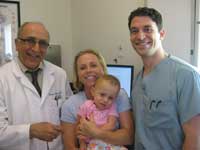 The 5-hour drive to San Diego was an unusually long and uneasy trip for us. Our thoughts were consumed with uncertainty and horror stories of spinal fusions gone wrong. We had a plethora of questions and hundreds of concerns about our daughters’ future. After reviewing Colbie’s records in his office, Dr. Akbarnia walked into our room, took my hand and said, “You’re in the right place.” He, and his surgical team, including Gregory M. Mundis, Jr., MD and their fellow, “Dr. Sam” Schroerlucke, spent the next hour and a half explaining in detail Colbie’s unique spinal situation problem and their intricate surgical strategy to Geoff and I. Leaving the office, we were still extremely nervous about the upcoming surgery, but meeting Dr. Akbarnia’s team reaffirmed our decision to seek their expertise and provided us the absolute best hope to save our daughter’s freedom of movement.
The 5-hour drive to San Diego was an unusually long and uneasy trip for us. Our thoughts were consumed with uncertainty and horror stories of spinal fusions gone wrong. We had a plethora of questions and hundreds of concerns about our daughters’ future. After reviewing Colbie’s records in his office, Dr. Akbarnia walked into our room, took my hand and said, “You’re in the right place.” He, and his surgical team, including Gregory M. Mundis, Jr., MD and their fellow, “Dr. Sam” Schroerlucke, spent the next hour and a half explaining in detail Colbie’s unique spinal situation problem and their intricate surgical strategy to Geoff and I. Leaving the office, we were still extremely nervous about the upcoming surgery, but meeting Dr. Akbarnia’s team reaffirmed our decision to seek their expertise and provided us the absolute best hope to save our daughter’s freedom of movement.
The doctors explained to us that Colbie’s spine didn’t develop correctly and she was missing 2 important blocks of bone in the front of the spine needed to bear the weight of the upper body. Without these blocks (vertebral bodies), the spine can collapse, thus potentially leading to paralysis. In Colbie’s case, her spine fell forward, dislocating the upper and lower half of her spine and putting direct pressure on her spinal cord. Her difficulty with walking was a sign of neurological injury and weakness, and without urgent surgical treatment, she would unquestionably become paralyzed. In fact, the doctors were amazed that she was even able to walk at all in her condition.
It was recommended she have surgery to remove the pressure from her spinal cord and correct the physical deformity causing the sharp angle in her spine (posterior decompression, multilevel vertebral column resection (VCR), posterior spinal fusion and instrumentation with multilevel posterior osteotomies). The surgery was very complex and the risks and possible complications that were explained to us were great, but we knew we had no choice but to trust this surgical team with our daughter’s life.
Four short weeks after the original diagnosis in Las Vegas, and two weeks after our initial consultation with Dr. Akbarnia, we drove back to San Diego for Colbie’s surgery. In retrospect, I’m not sure what was worse, the 8 pain-staking hours we spent in the waiting room during Colbie’s surgery, or the 113 long days our girls spent in the NICU. Words cannot describe the relief we felt when we saw Dr. Akbarnia walk in eating ice cream, then tell us how Colbie’s surgery went. We knew things had to have gone well!! Despite the extremely complex surgery, he explained that they had achieved the best possible outcome and that only one surgical incision had been necessary instead of the two he originally expected. “From a technical standpoint, her surgery went perfect,” said Dr. “Barney” (as Colbie called him). However, based on the spinal monitoring during surgery, they did anticipate some weakness with her left leg, but expected that this would improve over time.
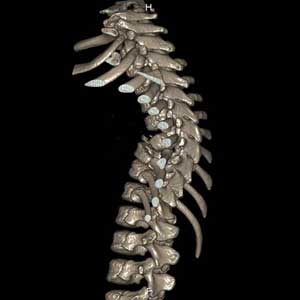 |
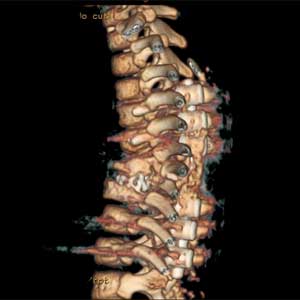 |
| Pre-Op | Post-Op |
Even though we were elated that her surgery went splendidly, we knew that she would have a long road to recovery. In the days and weeks to follow, she had significant pain. Colbie also had to wear a protective back brace (that she called her “shell”) for the first three months following the surgery. As parents, the recovery was hard enough to endure, but due to her young age, it was even more excruciating because she couldn’t fully communicate her needs to us. One major obstacle post-surgery was that Colbie could not walk. She was old enough to know that she should be walking like her twin sister, so she became extremely frustrated when she tried and nothing happened. One day Colbie broke my heart when she looked at me and said, “I’m stuck Mama, I’m stuck.” However, 5 weeks after her spinal procedure, she taught herself to walk for the second time! After she took a few wobbly steps, she got a huge grin on her face, started squealing with excitement and even attempted to run!
The next two years she endured physical therapy once a week to strengthen her left leg and build her core strength. She also had to wear a special leg brace (AFO) until age 6 to improve her “muscle memory” on her left side and balance her gait. Throughout the recovery process Colbie participated in a variety of recreational activities. She has engaged in gymnastics, creative tap and ballet, painting, swimming lessons and basketball camp. Currently, she is actively participating in organized soccer, yoga for kids (Teeny Yogini), and karate classes. She might not be as tall or fast as other kids her age, but she is able to partake in any activity or sport her heart desires, thanks to Dr. Akbarnia and his team. She has learned that “It is not how tall you are, but rather how tall you play!” Colbie is well aware of her tough start to life and is proud to show her scar and tell her story to anyone who’s interested.
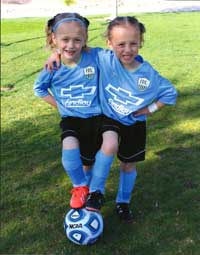 Throughout the entire discovery, surgery, and recovery process, Geoff and I had to deal with insurance issues for Colbie. Like many American families, we are required to see physicians who are in network, or face huge financial penalties. Staying within network is all well and good unless you have a rare problem such as Colbie’s that needed immediate attention. We learned from our experience in the NICU, that no matter the expense or bureaucratic hurdles, we had to be our child’s advocate for medical care. So we proceeded with her surgery in San Diego despite the looming insurance battle we would certainly undertake. This meant we were responsible for paying a large portion of every medical bill received from all of her surgeons, the hospital, and all other associated services, because we were “out of network.” While making minimum monthly payments to all of them, Geoff and I had to prepare a detailed file and twice appealed to our insurance carrier’s decision not to cover all or most of the bills. We learned patience, determination, and ultimately we persevered. A year later, the decision was overturned and our financial situation, which could have been disastrous, was eventually resolved thanks to the willingness of the providers to work with our insurance plan.
Throughout the entire discovery, surgery, and recovery process, Geoff and I had to deal with insurance issues for Colbie. Like many American families, we are required to see physicians who are in network, or face huge financial penalties. Staying within network is all well and good unless you have a rare problem such as Colbie’s that needed immediate attention. We learned from our experience in the NICU, that no matter the expense or bureaucratic hurdles, we had to be our child’s advocate for medical care. So we proceeded with her surgery in San Diego despite the looming insurance battle we would certainly undertake. This meant we were responsible for paying a large portion of every medical bill received from all of her surgeons, the hospital, and all other associated services, because we were “out of network.” While making minimum monthly payments to all of them, Geoff and I had to prepare a detailed file and twice appealed to our insurance carrier’s decision not to cover all or most of the bills. We learned patience, determination, and ultimately we persevered. A year later, the decision was overturned and our financial situation, which could have been disastrous, was eventually resolved thanks to the willingness of the providers to work with our insurance plan.
Would we do this again, knowing what we know now? In a heartbeat! Despite the hardships and obstacles we faced as a family, we grew stronger from the experience. We have fond memories of Dr. “Barney,” Dr. Mundis and “Dr. Sam”, as well as countless others who went above and beyond to get her surgery scheduled so quickly and work with us. We are forever grateful to Dr. Akbarnia and his associates for giving our daughter the gift of mobility and leading a “normal” life.
Finally, it is Geoff’s and my wish to share our pearls of wisdom from our experience. First of all, BE YOUR CHILD’S ADVOCATE!! Know that it is okay to ask questions, to disagree with providers and insurance plans, and to challenge their findings. It’s okay to request additional opinions, especially if you are getting differing opinions. When it comes to your children, you have to do what is best for them. Also, life is unpredictable so NEVER TAKE THOSE YOU LOVE FOR GRANTED. If you have a strong system of support from family and friends, embrace it and count on it in times of need. Each day together is most certainly a gift. Hug your children a little closer after reading this story. Thank your child’s doctor, teacher, or therapist the next time you see them. Let them know how important they are to your child’s life. Finally, DON’T EVER GIVE UP! If you don’t fight for your child, then who will?
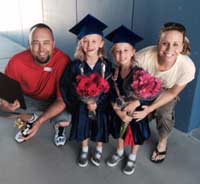 We would like to sincerely thank Dr. Akbarnia and Dr. Mundis for being the lights at the end of our tunnel, and for affording our daughter the gift of movement free from pain, disfigurement and restrictions. Additionally, we would like to thank the San Diego Spine Foundation for allowing us to share Colbie’s story with you. We hope it brings you peace and promise for your situation.
We would like to sincerely thank Dr. Akbarnia and Dr. Mundis for being the lights at the end of our tunnel, and for affording our daughter the gift of movement free from pain, disfigurement and restrictions. Additionally, we would like to thank the San Diego Spine Foundation for allowing us to share Colbie’s story with you. We hope it brings you peace and promise for your situation.
Shelby and Geoff W.
Proud Parents of Colbie and Kenna W.
